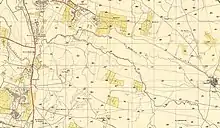Ma'abarot, Israel
Ma'barot,[2][3][4] often called Ma'abarot, is a kibbutz in Emek Hefer in central Israel. Established in 1933 and located about 11 kilometers (6.8 mi) northeast of Netanya,[5] it falls under the jurisdiction of Hefer Valley Regional Council. In 2019 it had a population of 986.[1]
Ma'barot
מַעְבָּרוֹת معبروت | |
|---|---|
 | |
 Ma'barot | |
| Coordinates: 32°21′50″N 34°54′15″E | |
| Country | Israel |
| District | Central |
| Council | Hefer Valley |
| Affiliation | Kibbutz Movement |
| Founded | 1933 |
| Founded by | Romanian Hashomer Hatzair members |
| Population (2019)[1] | 986 |
| Website | www.maabarot.org.il |
History
Ma'barot was the third kibbutz established by the Kibbutz Artzi federation and is located in the Sharon Plain, near the old road from Petah Tikva to Haifa. It was founded by members of the left-wing Hashomer Hatzair Zionist youth movement in Romania who organized themselves as a settlement group, and immigrated to Mandate Palestine in 1924.
Upon their arrival in Palestine, the group waited several years until land for settlement was available. They worked as hired laborers in the meanwhile. In 1932, a large stretch of land in the Wadi Hawarith/Hefer Valley area was acquired by the Jewish National Fund of which a small part was given to the settlement group. Ten members established an initial presence on the land, constructing housing and farm buildings, and making a start in land amelioration, while the rest of the group continued its communal life in Hadera. In September 1933, they too moved to the site of Ma'barot, which was located in a swampy area near Nahal Alexander.[6]
Over the following years, the kibbutz membership was augmented by additional Hashomer Hatzair groups, from Bulgaria, Hungary, Germany (of which most members were Russian), and Chile.[7]
 A member of Kibbutz Ma'barot on guard duty, 1936
A member of Kibbutz Ma'barot on guard duty, 1936 Ma’abarot 1937
Ma’abarot 1937 Ma'abarot 1939 1:20,000
Ma'abarot 1939 1:20,000 Ma'abarot (Ma'barot) 1945 1:250,000
Ma'abarot (Ma'barot) 1945 1:250,000
Economy
In contrast to most other kibbutzim, which have embraced privatization and have done away with many of the communal aspects that historically characterized kibbutz life, Ma'barot remains heavily collectivized. There are no differential wages, with all members living off a budget that does not include any special compensation for work, the communal dining hall still operates, and over thirty committees regulate almost every aspect of life on the kibbutz.[8]
Ma'barot farms approximately 3,000 dunams (3 km²) of land. Cotton is the major cash crop, and other branches include subtropical orchard, fish-breeding ponds and a dairy barn. The kibbutz also operates three factories, two pharmaceutical factories and one metal factory:
- "TRIMA", which produces medical supplies
- "Ma'abarot Products", which manufactures veterinary medical supplies and feed additives for livestock, among them "BONZO" dog food and "LaCat" cat food.
- "Metal Ma'barot", which designs and manufactures industrial machinery for use in factories.
In addition, Ma'barot runs a drying plant that dehydrates a variety of foods. Foremost among these is Materna, a leading brand of infant formula.[9] In 2017, the kibbutz sold its remaining 49% share in Materna to Osem-Nestle for $156 million.[10]
Culture
In 1944, Nissim Nissimov, a composer with ties to the Labor movement organized a musical show inspired by the Song of Songs. In 1955, the French cellist Paul Tortelier, impressed by the ideals of the kibbutzim, spent a year at Ma'barot with his family. He composed "Israeli Symphony" based on his experiences.
Archaeology
Burial caves and artifacts from prehistoric settlements have been found on the grounds of the kibbutz.[11]
Notable residents
- Geva Alon, musician
References
- "Population in the Localities 2019" (XLS). Israel Central Bureau of Statistics. Retrieved 16 August 2020.
- Israel Exploration Journal, Volumes 47-48, Israel Exploration Society, 1997
- The New encyclopedia of archaeological excavations in the Holy Land, Volume 4, Israel Exploration Society & Carta, 1993
- The red tower (al-Burj al-Ahmar): settlement in the plain of Sharon at the time of the crusaders and Mamluks A.D.1099-1516, British School of Archaeology in Jerusalem, 1986
- Kraft, Dina (September 25, 2009). "By adapting, kibbutz movement finds success". Jewish Telegraphic Agency. Retrieved April 24, 2019.
- "Maabarot history". Archived from the original on 2015-12-13. Retrieved 2015-12-21.
- Wyman, Eva Goldschmidt (2013). Escaping Hitler: A Jewish Haven in Chile. Tuscaloosa, Alabama: University of Alabama Press. p. 125. ISBN 9780817318000.
- Gabison, Yoram; Amit, Hagai (March 3, 2017). "After the Exit, Kibbutzniks Debate What to Do With a Half a Billion Shekels". Haaretz. Retrieved April 24, 2019.
- Materna factory
- Gabison, Yoram; Amit, Hagai (March 3, 2017). "After the Exit, Kibbutzniks Debate What to Do With a Half a Billion Shekels". Haaretz. Retrieved April 24, 2019.
- Agelarkis, Anagnostis P.; Paley, Samuel; Porath, Yosef; Winick, Jennifer (December 31, 1998). "The Chalcolithic burial cave in Ma'avarot, Israel, and its palaeoanthropological implications". International Journal of Osteoarchaeology. 8 (6): 431–443. doi:10.1002/(SICI)1099-1212(199811/12)8:6<431::AID-OA439>3.0.CO;2-8.
External links
- Official website of the kibbutz (Hebrew)
- Ruvik Feigin, Ruvik Feigin: "What Used To Be (1925–1933): The First Eight Years of Kibbutz Ma'abarot" on Vimeo, 2013 Documentary on the founding of Hashomer Hatzair Kibbutz, ca. 11 kilometers north of Netanya
- On the lawn of Kibbutz Ma'abarot, documentary film
- Pictures on Flickr.com of international volunteers working in Ma'Abarot in the 1970s